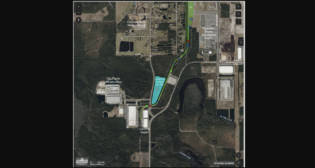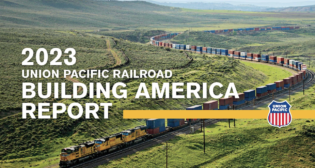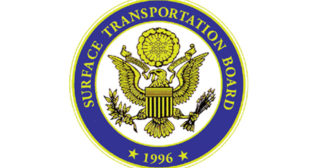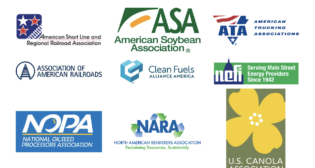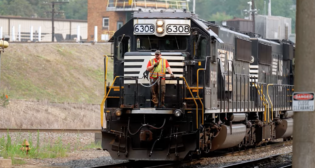
Midyear Report: Riding a tide of prosperity
Written by William C. Vantuono, Editor-in-ChiefWith traffic in most commodities on an upswing and capital investment at record levels, the railroads are on track for another prosperous year.
Just for a while, put aside talk of exploding crude oil trains and pending tank car regulations, or the U.S. Environmental Protection Agency’s proposed clamp-down on coal-fired utilities, and take a good look at the railroad industry’s current situation. Simply put, the overall picture is positive.
In this industry, every piece of good news comes with its caveats. On the whole, though, recent and ongoing developments add up to a positive picture of prosperity.
Capital spending is headed for a new all-time high exceeding $16 billion. BNSF alone is investing $5 billion this year, up from $4 billion in 2013.
A surge in traffic—including crude by rail—has created a surge in freight car orders. The Greenbrier Companies alone has reported orders for cars valued at nearly $1.7 billion, among them 3,500 Tank Car of the Future units.
As traffic as grown, so has employment. Train crews are among those being brought back on the job. In mid-May, total employment was up 1.13% to 166,097. Wall Street is looking favorably on railroad stocks, and more are trading at or near their 52-week highs.
The CBR boom, paradoxically, has elements of both bane and blessing. The emergence of a plentiful supply of cheap natural gas could cut railroad operating costs if it replaces costlier diesel fuel in locomotives; it is also, however, cutting power plant fuel costs as it replaces coal—a major blow to one of the industry’s largest sources of freight revenue. Further erosion of the railroads’ coal market is threatened by new and lower carbon emissions permitted by the EPA.
Intermodal growth has been a common thread among the Class I’s, as related by their chief financial officers at recent analyst conferences. “We are seeing continued opportunities for highway conversion, continued growth in Crescent Corridor services, growth with international shipping partners, and continued growth from new facilities, our South Carolina Inland Port, and Charlotte Terminal,” Norfolk Southern CFO Marta Stewart told the Wall Street community in May. Even the depressed coal market is exhibiting signs of waking up, with “improved demand for utility coal due to weather, stockpiles reduced from 67 to 44 days’ supply, and strong competition in the Atlantic metallurgical and thermal markets, [despite] contract losses in utility coal and reduced domestic metallurgical coal volumes related to plant closures and sourcing shifts.”
NS merchandise traffic is on the upswing as well, with “projected growth in crude oil, and increased volume for shale-related liquid petroleum gases and asphalt,” said Stewart. NS is also benefitting from “gains in steel and frac sand, a favorable corn and soybean crop for 2013/2014, an improved housing and related construction materials market, and continued automotive growth. Our automotive volume rose 7% in 2013. With average vehicle age at an all-time high, North American light vehicle production is forecasted at 17.1 million units for 2014, up 3.6% vs. last year.”
“CSX has overcome the transition in the energy markets,” said CFO Fredrik Eliasson. “This year is expected to be the last year of the coal transition. Domestic growth is now expected; export volume and price remain challenged.”
CSX’s strong first-quarter financials largely resulted from “non-coal revenue growth, inflation-plus pricing, and efficiency. Second quarter volume has accelerated, and our operations are stable, with gradual recovery expected in the second half of 2014. Our diverse portfolio is key to sustainable earnings growth—business is now the most diversified in the company’s history, and our financial outlook remains positive long-term. Expect modest EPS growth in 2014 and double-digit growth beginning in 2015.”
A significant decline in utility coal should be more than offset by gains in other areas, according to Eliasson. “Our merchandise and intermodal revenue grew $2.7 billion,” he said. “A record harvest in 2013 helped our grain markets recover. Initial 2014 crop projections are strong, with crop production constant, despite smaller corn acreage. Lower corn prices are spurring growth, and ethanol and poultry production have rebounded. Housing starts are expected to grow 12% from 2013, though expectations for 2014 are still 30% below the historical average. Housing starts drive about 6% of CSX business, through lumber and building products, agregates and waste, metals and plastics, intermodal, and household appliances.”
Like most carriers, CSX’s chemicals traffic “is driven by a surging oil and gas industry,” said Eliasson. “Our crude oil volume could double in 2014, with further growth long-term. Frac sand is expected to rise about 10% in 2014, driven by Utica shale. Metals growth is based on a 5% forecasted increase in steel production, with oil and gas plays driving demand for drilling and transmission pipe. Automotive strength continues, with North American light vehicle production growth expected to again outpace Gross Domestic Product growth in 2014.”
New or expansion projects on CSX totaled more than 120 in 2013—about 570 during the past five years, representing 150,000 carloads once these projects are fully on-line, and nearly 620,000 over the past five years. “Our project pipeline for 2014 is healthy,” said Eliasson. “It’s driven by substantial chemical-related activity. Customer investments have totaled $15 billion since 2009, creating long-term growth.”
CSX’s hub and spoke-style intermodal network “has been a key differentiator,” said Eliasson. “It has created a broader reach into eastern U.S. markets for us. More than 125 new Northwest Ohio lanes are driving 20% of total volume growth. Our Northwest Ohio Terminal is at capacity and is being expanded by 50% this year, to support new investments in Montreal and Florida markets.”
CSX says its total eastern intermodal opportunity is about nine million truckloads, reflecting truckload moves greater than 550 miles. “A significant majority overlays our intermodal network, and our H2R (highway to rail) initiative is designed to capture that growth opportunity. Capital investment will be required over time, and investments are scalable as volume increases,” said Eliasson.
Longer-term, CSX is targeting a mid-60s operating ratio. “Our diverse business portfolio will drive growth on a sustainable basis,” said Eliasson. “Nearly all our markets now have positive trajectory, including domestic coal. Profitable volume growth, inflation-plus pricing, and efficiency gains are driving our success.”
Union Pacific, according to CFO Rob Knight, continues to benefit from “safe and resilient infrastructure,” which is being further improved via UP’s $4.1 billion 2014 capex program. The railroad is devoting major dollars to capacity improvements on its Southern Region, and is acquiring 229 new locomotives this year and other rolling stock—a $975 million spend. PTC expenditures, at $450 million, also represent a significant chunk of capex.
UP set first-quarter records in operating revenues, income, and ratio, and in earnings, despite a challenging winter. Knight attributes these improvements to the railroad’s “resource agility and surge capacity.” Much of this is related to intermodal, where UP sees “a significant domestic truckload conversion opportunity, and truckload opportunities in Mexico,” where UP is the only railroad serving all six major border gateways, he says. “Trucking’s traditional advantage is eroding, through regulations and rising costs, and highway congestion and infrastructure deterioration.”
And like all its Class I brethren as well as the numerous short lines and regionals that take traffic to and from the national linehaul network, UP provides “a strong value proposition.”
A few caveats
“There’s little fault to be found in these stars,” says Cowen & Company Managing Director and Railway Age Wall Street Contributing Editor Jason Seidl. “Rail stocks have continued to advance this year, plowing through the most difficult winter weather that we have seen in decades. The strength has been partially attributable to the strong bounce-back in traffic and a slow improvement in the outlook for pricing truck-competitive business. The big debate among investors continues to be over the strength in the macro environment, and just how much of rail traffic gains can be attributed to volume pushed into second-quarter 2014 due to weather, along with intermodal volumes pulled forward anticipating a potential West Coast port strike.”
Seidl says this debate “is indeed an interesting one. When you look at the quarter-to-date traffic ending in mid-June, you will see that if we exclude coal (clearly a weather-driven commodity) and grain (very little has to do with the economy), rail volumes are up nearly 7%. This is indeed a strong showing, but is likely impacted by shippers pulling forward a portion of their intermodal moves due to fears of a West Coast port strike. The International Longshore and Warehouse Union was looking at its contract expiring at midnight on June 30th, making shippers eager to move their cargo sooner. But, even if we assume that half of container growth can be traced to shippers’ fear of a strike, quarter-to-date volumes are still up roughly 5%.”
“These volume gains have come at a price, especially given that rail service problems rolled over from the first quarter,” cautions Seidl. “Indeed, some of the service issues facing the industry may not be resolved until 2015. The railroads have not been very good at handling strong spikes in demand in the past and it appears that this inability to deal with surges in traffic continues to plague them to this day. To be fair, they were dealing with harsh weather in the first quarter and now have been throwing the two Ps (people and power) at the problem, with some carriers announcing record capital spending budgets. Hence, in the near term, some railroads may not bring as much to the bottom line as they could in a more operationally sound environment.”
Yet, on a brighter note, at least for investors, “it appears that the pricing environment is improving for truck-competitive freight,” says Seidl. “This improvement has been long awaited, especially in the intermodal segment that has seen its pricing growth grounded in recent years due to the lackluster truckload rate environment. However, this all changed when winter weather conditions showed just how fragile the supply/demand mix was in the truckload market. It got so bad in some areas that brokers were reporting load-to-truck ratios in the 20s. While the market has calmed down from those frantic times, it still remains pretty tight and has the ability to worsen with any future shocks. It is this ability that is letting shippers feel comfortable about signing truckload freight contracts with price increases that are in the 3% to 7% range. While we do not expect the railroads to match truckload prices one for one, we have seen some announcements for intermodal rate increases of 3% to 5%.”
“Looking out over the next year, we believe railroads will be able to grab a larger slice of the proverbial transportation pie, as the supply constraints on the truckload market do not look like they will abate any time soon,” notes Seidl. “In fact, we can state that the current driver environment is the worst we have seen over the past 20 years. Combine the driver issue with a crumbling highway infrastructure and limited funds to fix it, and the railroads look like they are going to walk away with more business, as freight finds a way to get delivered regardless of challenges. This overall tightness in the North American supply chain should enable the rail industry to keep pricing above its cost inflation, thus moving margins higher over time. Railroads should also continue to use their free cash flows to benefit investors through share repurchases and dividend hikes. Railroad stocks will continue to be a good place for investors.”
One example: Canadian Pacific, which under CEO Hunter Harrison has seen its stock price triple. “Harrison stands by projections to double revenues in seven years, and even suggested that such projections may prove conservative,” Seidl notes. “A multitude of factors could contribute to the growth, including the economy, market share gains, and well-above-GDP increases in various segments, namely domestic intermodal and merchandise. With domestic intermodal, while CP aims to win market share, this opportunity is somewhat limited by the fact that only 30% of CP’s domestic intermodal traffic is in competitive lanes. The bigger portion of the growth should continue to come from highway conversions. As CP and its Class I brethren continue to invest in their intermodal networks and improve service levels, more manufacturers and retailers will likely be swayed by the cost advantages and better access to capacity associated with intermodal relationships.”
